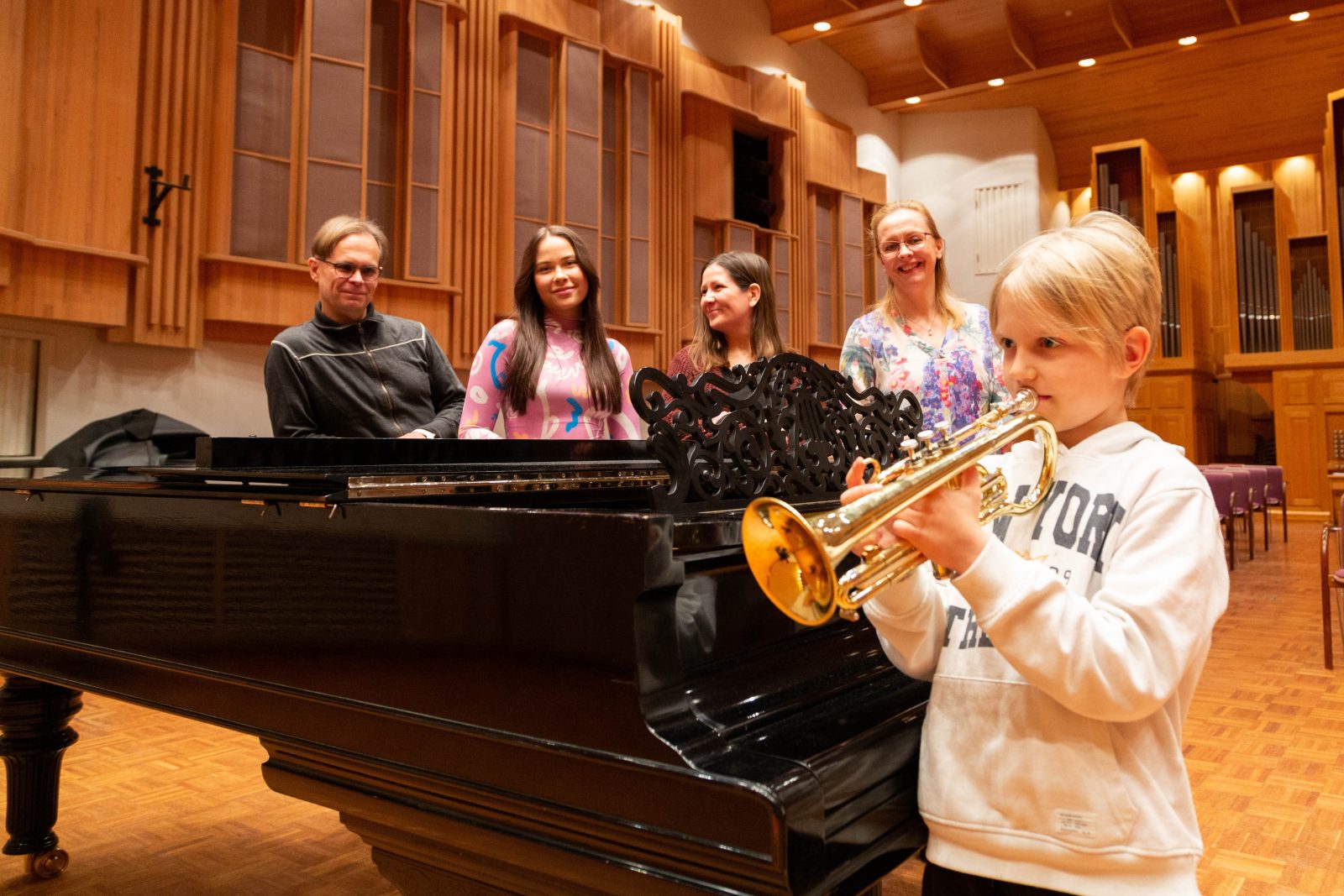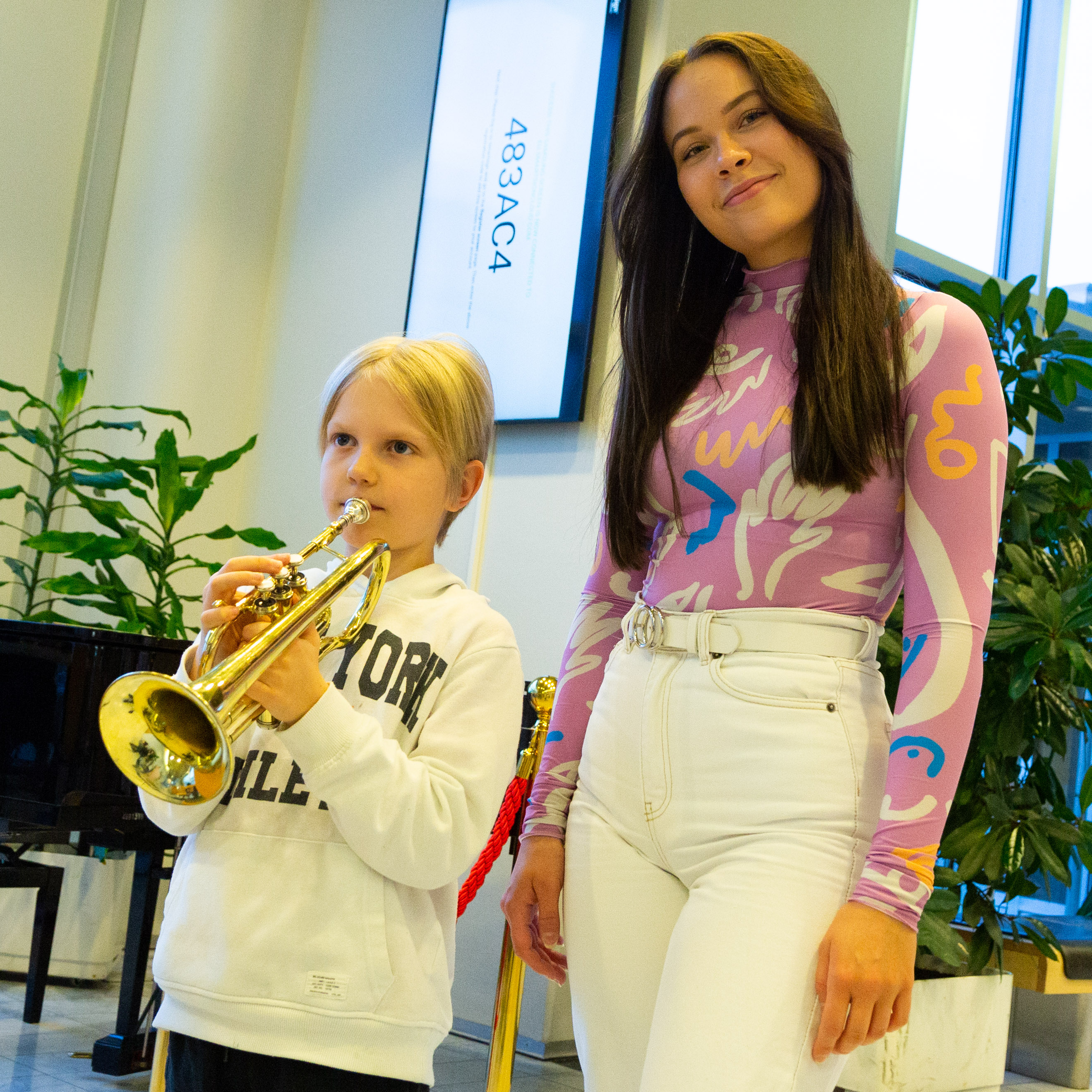My Oulu: Good team spirit is the strength of the 70-year-old Oulu Conservatoire – teachers can learn from their students

Kantele teacher Antti Paakinaho (left), vocal student Oona-Karita Isokoski, principal Noora Tuominen, chamber pianist lecturer Sanna Smolander and young trumpet player Eino Juntunen are all celebrating the 70-year-old conservatoire this week. Photos: Pasi Rytinki
Oulu Conservatoire began its 70th anniversary week on Sunday. There will be many celebatory events in Oulu until November 19th.
”I would say that the atmosphere is busy, but also happy and expectant. A lot of interesting events are coming, but of course it has kept both staff and students busy,” said the conservatory’s principal Noora Tuominen right before the week began. Preparation for the anniversary week began last spring.
”During the week we try to present the different functions of the conservatory fairly comprehensively, although of course there is no way we can fit everything in,” says chamber pianist lecturer Sanna Smolander.
The main event of the week, a celebratory concert for invited guests, is scheduled for Wednesday. It will include, among other things, a commissionded work called Intrada for brass and percussion by Oulu-based composer Juha Pisto.
Basic education and professional studies
The conservatoire was founded as Oulu music school in 1952. Since 1961 the conservatoire has been owned by the city of Oulu.
The school got its conservatoire status in 1978, when it got the license to start music teacher and orchestra musician training. In the 1980s, church musician training (1984) and music instructor training (1987) were added. Dance teacher training began in 1991, and in 2000 the rhythm music department was established. The music teacher, music instructor and dance teacher trainings ended in 2003, as universities of applied sciences continued the training leading to these degrees.
Currently, the conservatory offers basic art education for children and young people as well as vocational secondary education in classical music, rhythm music and church music. The premises are in three places – Oulu Music Center, Kotkantie and Oulunsalo-talo – and there are approximately 1,100 students in total.
Performing is important for teachers
What is the secret for the success of the 70-year-old institution? Principal Noora Tuominen highlights the good artistic and pedagogical quality and versatile selection for studies.
”Of course, enthusiastic and competent personnel is also important. Many of our teachers want to get additional education all the time, thus maintaining and developing their own professional skills,” says Tuominen.
Sanna Smolander points out that teachers also perform a lot. Every year, the conservatoire’s teachers organize the Tulindberg week, where they perform themselves.
”There is a good team spirit here, it always feels good to come to work,” says Smolander.
Antti Paakinaho, teacher of kantele, agrees.
”These joint concerts very much strenghten my own work,” says Paakinaho. He believes that teachers’ performances not only develop their teaching work, but also have an inspiring effect on students.
Friendly community
Oona-Karita Isokoski, who studies singing at the rhythm music department, agrees with the teachers on the good atmosphere.
”We have a really good atmosphere at the rhythm music department. We are a pretty small group, and everyone is friends with each other. Whenever we have joint days with the classical and church music departments, we get along well with them, too. In my opinion, the students’ co-operation works really well, you can ask anyone to join if you have gigs coming up, for example”, says Isokoski.
Isokoski agrees with Paakinaho on the teachers performing having a positive impact on students.
”That’s the main thing, performing. It’s a really nice that while we’re learning, we can also be colleagues in a way, we talk about the same things and have the same understanding about the music. The students are certainly excited that the teachers perform so much.”
”This probably encapsulates the secret of the conservatoire’s longevity and success. If there is a good atmosphere in the working community and it is pleasant to come to work, it will spread throughout the entire place”, states principal Tuominen.
Shared insights
It is also important for the educational institution to stay up-to-date, while also maintaining basic values and traditions. Paakinaho points out that the students are, in a way, also teachers of their teachers.
”I’ve been doing this for almost half a century. I have learned a lot from my own students and it has developed me in my own work,” says Paakinaho.
”I can relate to that. Many times during our lessons we have sudden moments of shared insights with our teachers, and that’s really nice,” says vocal student Isokoski.
She adds that there is no competition between the students, either.
”At our department we have very different singers, and it’s so nice when everyone can get support and inspiration from each other for the things that maybe are not their strengths yet.”

”Playing together is really important for children and young people. Even the youngest students have the opportunity to play chamber music and participate in orchestra activities, depending on the instrument. The students also perform a lot together. We have student concerts almost every night, and anyone can come and listen to them”, adds Smolander.
An antidote to the modern times?
The conservatoire staff is not worried about families and children losing interest in classical music and traditional instruments. There has never been a lack of students, and many families have found a traditional hobby of music to be a good idea in today’s endlessly stimulating everyday life.
”I think that parents have a really good awareness of the things that threaten our children nowadays. Practising music is a really good antidote: long-term work that requires concentration, often one-on-one with a teacher. It really has a positive impact”, says Smolander.
”You also have to listen to the student’s preferences, what kind of art he or she wants to produce. A teacher should not stick to a strict formula”, Paakinaho points out.
It is also good to remember that music is developing constantly. A good example is the traditional Finnish instrument kantele, taught by Paakinaho. Despite its ancient image it’s a relatively new instrument, especially if you consider how it’s used and taught today.
”You can do anything with it these days, it’s an extremely versatile instrument! I’ve encouraged the students to study it properly, do all kinds experiments with it”, says Paakinaho.
Hobbyists are welcome
The conservatoire is not meant only to produce music professionals, let alone stars. It’s equally open to hobbyists who don’t pursue a professional career in music.
”Everyone follows their own path, and we strive to offer a variety of paths towards what their goals are. Just as important as top-notch professionalism is the fact that we nurture music as a lifelong hobby”, says principal Tuominen.
Teachers say that they occasionally come across an unnecessary fear of incompetence, which prevents people from applying to the conservatoire. Of course, there is a queue for the most popular instrument studies, but in principle the starting level of the student does not have to be high.
”When I was younger, I felt exactly the same way. I would have been interested in coming here many years earlier, but I thought you couldn’t be a complete beginner – and I was clearly wrong about that. When I finally got here, I noticed that the teaching always starts from everyone’s individual level, no matter what it is. There’s really no need to think you have to be super good right from the start” says Isokoski.
Paakinaho strongly agrees.
”The entrance exam is such a strange situation that you don’t always get a good idea of the student’s skills. It has often surprised me later how much hidden talent there can be found behind the nervousness of the situation” he says.
More information about Oulu Conservatoire: https://www.ouka.fi/oulu/oulun-konservatorio/in-english